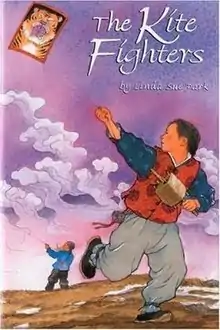The Kite Fighters
The Kite Fighters is a 2000 historical children's novel that was written by Linda Sue Park and illustrated by her father Eung Won Park.[1] It was first published on March 20, 2000 through Clarion Books and follows two brothers in Korea during the 15th century.[2]
 First edition cover | |
| Author | Linda Sue Park |
|---|---|
| Illustrator | Eung Won Park |
| Country | United States |
| Language | English |
| Genre | Children's fiction |
| Published | 2000, Clarion Books |
| Media type | Print, ebook, audiobook |
| Pages | 144 pages |
| ISBN | 0395940419 |
Plot
Set in Seoul, Korea, in 1473, the novel depicts the relationship of two brothers in a tradition-bound family. Lee Young-sup is acutely aware of the difference in his status being a younger brother, but he finds a true talent the first time he flies a kite. First-born son Kee-sup is under pressure from his father, a rice merchant, to advance the family honor by becoming a court official; he spends much of his time studying for the position, though it is not his true life goal. Young-sup's growing expertise in flying kites and Kee-sup's craft in making them draw the attention of the boy-king of Korea, modeled after King Songjong, and they become friends with the king outside of the ancient protocol and secretly represent him for the kite-fighting competition during the New Year's festival. It is the tension between traditional duties and individual needs. The boys later get into a fight with a boy who is trying to rob them but they are unsuccessful and have to start from square one. They recover their money and are helped by the King, who gives them new kites. By helping the boys get new kites the king is also one of the main characters because he held them at his temple
Reception
Critical reception has been positive.[3][4] January Magazine praised The Kite Fighters for "[painting] a realistic picture of coming of age in Korea in 1473" and "[relaying] a timeless, compelling story that easily translates to our own age".[5] Kirkus Reviews also gave the book a positive rating, as they appreciated the book's resolution came out of the hard work of several people as opposed to it being a "foregone conclusion".[6]
References
- McElmeel, Sharron L. (2004). Children's Authors and Illustrators Too Good to Miss: Biographical Sketches. Libraries Unlimited. p. 265. ISBN 1591580277. Retrieved 1 June 2014.
- "The Kite Fighters (Book Review)". Reading Teacher. 55 (3): 247. November 2001. Archived from the original on 2014-06-01. Retrieved 1 June 2014.
- Vidor, Constance (2009). "Children's Book Review: The Kite Fighters". International Journal of Multicultural Education. 11 (2): 3. Retrieved 1 June 2014.
- "The Kite Fighter (review)". Publishers Weekly. Retrieved 1 June 2014.
- Remick, Lynne. "The Kite Fighters (review)". January Magazine. Retrieved 1 June 2014.
- "The Kite Fighters (review)". Kirkus Reviews. Retrieved 1 June 2014.